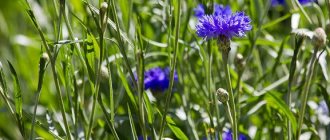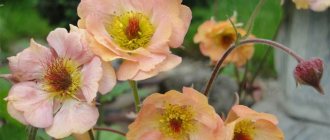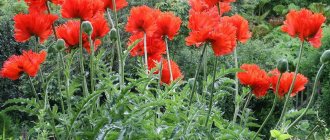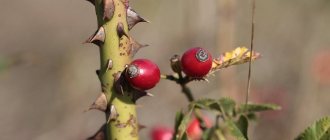Exotic amaryllis, it would seem, is common as a houseplant. However, having placed it in the garden, one can only be surprised and delighted at how much this plant will transform the landscape design. This bulbous perennial plant came from Africa and successfully settled in our culture.
Large flowers of white, red or pinkish color are arranged on long dense arrows of 6-12 pieces. Blooming in the fall, each arrow forms a lush bouquet that will attract a bright spot from all over the garden.
Varieties and varieties of amaryllis
Amaryllis has only one species - Amaryllis belladonna. White or pink flowers look like large lilies; from 6 to 12 pieces grow on one peduncle. The leaves die off in the spring, and amaryllis blooms at the end of summer, which is why many, looking at a photo of a blooming amaryllis, try unsuccessfully to find leaves on it.
Amaryllis belladonna
Three varieties are most common in culture:
- Blanda. It is distinguished by large white but unscented flowers.
- Maxima. The inflorescences are pink, fragrant.
- Purpurea. This variety is famous for its large purple flowers that are yellowish inside.
Attention. Amaryllis juice is poisonous.
Planting in open ground
Most often this flower can be found in pots. There are reasons for this. Amaryllis is very thermophilic and does not tolerate wintering in open ground. But some gardeners successfully grow it in gardens. Areas with mild climates are more suitable for this. In the conditions of the middle zone, it will be more difficult to grow this crop in open ground. However, a flower that grows in open ground blooms more luxuriantly than its counterparts in pots.
To plant amaryllis, choose the sunniest and warmest place on the site.
Choose sunny places protected from the wind. The plant will feel good on the south side of buildings and among stones.
The soil should be well fertilized. It is also very important that the soil drains well. The bulb must be deepened by 15 cm and a gap of at least 30 cm must be maintained between plants.
Selecting seeds for a greenhouse
It is very important to choose the exact variety of tomato that will be suitable for the greenhouse. There are special “greenhouse” varieties that should be given preference first of all. They grow well in a greenhouse and produce a high-quality and rich harvest. These include:
— Bull's heart. This species is characterized by very high productivity, large and pleasant-tasting fruits.
— Miracle of the Earth is the most ideal variety for greenhouse conditions.
— Samara has sweet and juicy fruits. This variety grows well in a polycarbonate greenhouse.
— Long keeper, with proper care, can produce a harvest of up to 4 kilograms per bush.
— Moneymaker is an early variety that can be planted in a greenhouse in March and harvested in early summer.
— Dina is an excellent variety for greenhouses, which produces a yield of up to 5 kilograms per bush.
There are also more exotic varieties.
Read: Aphelandra«>
Amaryllis care, fertilizer and feeding
The first shoots appear in the spring. Gardeners advise not to water the plant until the peduncle reaches 10 cm. Otherwise, the leaves will take all the strength necessary for flowering, and the peduncle will grow much slower. From now on, it is necessary to apply fertilizer once every two weeks. And water the crop as the soil dries, trying not to flood the bulb.
Feed your amaryllis regularly during the flowering period.
Since the peduncle is most often thin and long, you can make a support. If the flower has enough care, then by the beginning of autumn the amaryllis will begin to bloom. Flowering can last up to 8 weeks on leafless flower stalks. Towards the end of flowering, the plant will begin to produce leaves that should not be trimmed. After the amaryllis has faded, watering and fertilizing must be gradually reduced so that the crop enters the dormant phase.
Before the onset of cold weather, the bulbs are dug up and transplanted into pots that need to be placed in a warm, bright place.
Attention. Do not forget to water and feed the transplanted bulbs in winter, because at this time they gain strength for new flowering.
Watering
Amaryllis and hippeastrum - differences, what is the difference
Before flowers appear on the plant, it should be watered moderately. It is only necessary to moisten the soil to prevent it from drying out. Experienced flower growers, from personal experience, generally recommend refraining from the procedure. Then, when the buds set, the amaryllis should be watered generously until the flowering period ends. It is better to use settled warm water, rainwater will do.
Not only waterlogging, but also drying out of the soil is dangerous for the plant, so you need to find a middle ground. To retain moisture, you can use sawdust when mulching the soil.
Mulching with sawdust
Amaryllis propagation
Amaryllis is most often propagated using the traditional bulbous method - by separating daughter bulbs. Small bulbs must be planted at the same depth in which they grew before transplanting. In two years, the young bulbs will already grow to the size of the mother.
Amaryllis bulbs
There is another way. You can divide a large onion into sections. The main requirement for the divisions is that each of them must have a piece of the bottom and several old scales. Some bulbs can even be divided into 30 or more parts. The sections must be immediately sprinkled with ash or crushed activated carbon. The central part of the bulb, on which there are the makings of leaves, is not used.
Delenki need to be planted in the sand and kept warm. In a month they will give the first leaves. When the second leaf appears, you can replant the plant in loose soil.
Amaryllis sprout
If you decide to try to propagate amaryllis by seeds, you should remember that the seeds lose their germination very quickly, so they need to be sown almost immediately after harvesting.
Attention. A flower grown from seeds does not retain maternal characteristics and blooms only in the seventh year.
Transfer
These flowers are perennials, and under favorable conditions they can not be replanted for 3-4 years. If you planted amaryllis or hippeastrum in the ground for the summer, and the winter promises to be frosty, then the flower bulbs need to be dug out of the ground.
After the amaryllis bloom, you can begin replanting - this is done when the leaves of the hippeastrum or amaryllis dry out. The bulb is transferred from the soil to the pot at the beginning of the dormant period.
If you grow amaryllis only at home, then every 3-4 years the container for the flower should be replaced with a larger one. In this case, it is advisable to renew the soil, since it will probably be depleted by the time of replanting.
When transplanting, the bulbs of hippeastrum and amaryllis are examined and treated, the roots are shortened a little, and the children are separated, which can be planted in a separate pot.
Diseases and pests of amaryllis
With proper care, this perennial flower rarely gets sick. Sometimes you can see a red burn on amaryllis. To treat it, you need to soak the onion for up to two hours in a solution of potassium permanganate, and treat the wounds with brilliant green and sprinkle with crushed coal. Then leave the onion in the air for about a week and plant it in fresh soil.
Amaryllis bulb affected by red burn
If the plant is infected with a fungus, it is necessary to treat it with Bordeaux mixture and remove the affected leaves.
Solving Common Problems
Diseases, pests and violations of maintenance conditions have a negative impact on the appearance of amaryllis, slow down the growing season, and often prevent flowering. Let's look at possible problems and solutions.
Care errors
If the conditions of maintenance are violated, the amaryllis looks faded and unkempt, the foliage withers, the peduncle grows slowly, with a small number of weakened buds.
Blackening of flowers
Cold, excessively humid air leads to darkening of flowers. To solve the problem, reduce watering and raise the air temperature in the room above 18-20 °.
Slow growth
Slow development is caused by a lack of light, moisture, fertilizing, and damage by diseases and pests. Normalization of care and treatment is required depending on the problem.
Bulb rotting
Bulbs rot due to excess moisture, pest damage and fungal diseases. The solution is normalization of watering, treatment with insecticides and fungicides.
Brown spots
Yellow-brown spots are traces of the impact of the false scale insect. Amaryllis is treated with insecticides and folk remedies.
Yellowness of leaves
Excess moisture and aphid infestation can cause yellowing of the foliage. Watering is reduced and the pest is controlled.
Diseases
Most diseases are caused by infection of bulbs and soil by fungi. Excessive watering provokes the development of amaryllis diseases.
Stagonosporosis
Signs of red rot are stripes and spots on the bulb, then on the foliage, orange-red in color. Treatment - bulb extraction, pruning, treatment with fungicides.
Root rot
Signs: deformation, spots on the bulb, wilting of the green part. Treatment - pruning to healthy tissue, treatment with fungicides.
Fusarium
The scientific name for root rot. The disease is caused by fungi of the genus Fusarium.
Pests
Bulb pests are especially dangerous for amaryllis. The infection remains undetected for a long time, during which time the damage often becomes irreversible.
Onion mite
The pest eats the bulbs. It is usually discovered when the green part begins to fade. It is difficult to fight the mite; the plant usually dies.
False shield
Brown seals and spots on the foliage are traces of the false scale insect. Treating with a soap solution, Actellik, Aktara will help you cope with the pest.
Aphid
Weakened, yellowed leaves are a consequence of aphid infestation. Pests are removed manually using insecticides or folk remedies.
Mealybug
A white cottony coating on greens is a sign of mealybug infestation. The foliage becomes sticky and deformed. Physical removal and insecticides help.
Thrips
Stripes, spots, and holes on the foliage are left on amaryllis by thrips. This is a common type of pest that is combated by double application of insecticides - Actellica, Karate, Intavira.
Spider mite
When air humidity is low, spider mites quickly multiply on amaryllis, which can be seen by the thin mesh under the leaves. Treatment – insecticides, increasing air humidity.
Amaryllis mealybug
The white pest hides in onion scales, eating tissue. It is necessary to remove the bulb, excise the damage, and treat it with medications.
springtail
The white insect can be found on the soil. Destruction will require replacing the top layer of soil, treating with insecticides, and limiting watering.
Combination of amaryllis with other plants and use in landscape design
In landscape design, amaryllis can be planted along with other perennial flowers that bloom in early autumn. They will complement the bright autumn fireworks with their riot of colors. Amaryllis will also look good in solo plantings. You can combine several different varieties of amaryllis in one bed.
Some designers advise combining amaryllis with ground cover so that the flower stalks do not appear so bare. It will look great on sunny alpine slides among the stones. By looking at the photo with these flowers, you can easily determine the best place for amaryllis on your site.
Amaryllis in a flowerbed
Many people believe that amaryllis are best grown in pots, but this is not true. It is growing in open ground that gives amaryllis the brightest shades and richness of color. Although this flower will require some effort on your part during planting and care, this effort will more than pay off when the plant blooms. After all, the time for amaryllis to bloom is autumn: when everything around is covered with a golden carpet, the handsome amaryllis comes to the fore.
Growing for forcing
Hippeastrum is also grown for forcing. Moreover, you can achieve its flowering not only at the end of summer - beginning of autumn, but also for the New Year holidays. Having slightly shortened the dormant period, bring the flower pot into a warm room and wait for the flower arrow to appear. After this, begin to intensively water the hippeastrum.
For rest, forcing the peduncle and budding, the hippeastrum will need about 13 weeks. The dormant period takes approximately 2.5 months, and from the moment when the flower arrow appears until the moment when the hippeastrum blooms, about 3 weeks will pass. So for forcing by the New Year, you need to provide the hippeastrum bulb with a period of rest from October.
Varieties and types of amaryllis: photos
Growing amaryllis in the garden











